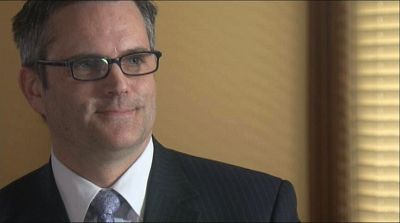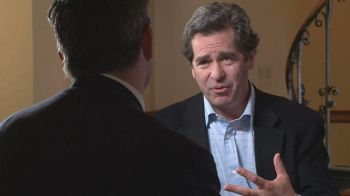Mayor of Portland, Oregon, 2009 –
Portland City Council member, 2005 – 2009
on the portland model
BLUEPRINT AMERICA: The city of Portland, today, is the result of a land-use planning movement in the early 1970s throughout Oregon, what was going on then?
MAYOR SAM ADAMS: It really was to protect farm and forest land. At that time we were especially dependent upon agriculture and the wood products industry. There were just the beginnings of sprawl that was fueled by the advent of cheap cars and cheap gas. And that really jolted the sort of core value that a lot of Oregonians hold – held then and hold now – in terms of protecting the environment. Now it just worked out that it helped protect the livability of the central sort of region and the downtown of the city.
BA: Prior to the 1970s, Oregon’s landscape – the dense forests and ranges of mountains – was, in a sense, a natural barrier to sprawl. But, as cities began to push against those seams, the state had to make a decision regarding future growth. How was that choice made?
SA: Oregonians saw what was happening in Los Angeles, they saw what was happening, even in the Bay area, and they didn’t want to replicate that here.
The state had this closely held value of protecting the environment that really cut across the political partisan lines. It was even a pro-business sort of proposal because it protected agriculture and timber, which, at that time especially, were our two biggest industries.
BA: When you think about it, strange bed fellows created this – it wasn’t just a bunch of hippies who decided to protect green space…
SA: It was strange bedfellows to have the lefty environmentalist hippie types and the timber barons – who tended to be very conservative – and the grass seed growers and the folks who grow nursery stock and food… They sort of all came together to impose on this state a really strict land use plan and urban growth boundaries. And, it really was focused on Portland – it was done to protect farm and forest land around the Portland area.
BA: In what sense then is Portland different from other American cities?
SA: The issues that confront Portland are no different than the issues confronting any other city in the United States of our size. How do you compete with the big megalopolises? How do you get attention from the federal government for funding? That’s no different than any other city. We’ve just chosen to do it a little differently here. We’ve chosen to prioritize a sustainable way of life here, more than a lot of other cities. And that shows up in everything from zoning to the kind of businesses that locate here. It is who we are.
BA: Still, some Americans may look at that and say, ‘people in Portland spend a lot on lattes and listen to NPR and watch PBS, too. And if they have a car, it’s an old Volvo…’
SA: That’s a stereotype that’s not exactly accurate. I think we represent the best in terms of American ideals of trying to be an egalitarian city – of really pushing the boundaries in improvement and progress. We embrace new ideas, we’re willing to take chances, smart, good risks, and we have fundamental values of not only having a good life for ourselves but trying to pass on a good life to our children and grandchildren. I think most cities would share that set of values.
BA: What about property rights? Telling people what to do with their property – as in Portland – that’s a big deal in this country, right?
SA: I think it’s important that there are individual rights. No question about it. I also think that there are collective responsibilities and I think Portland and Oregon work real hard to find that balance. Now in comparison to other places, we probably have enshrined more collective rights than a lot of other places, but it’s working for us. Not in every case – we’re not perfect – but fundamentally we go into the next chapter of the world economy, of this nation’s life in a pretty strong place. We’ve got our problems, but we’re in a lot stronger place than a lot of other cities by saying, ‘yes, you have individual rights, but there are also collective responsibilities and we’re willing to put them into law.’
We definitely have a very robust definition of what is the common good here. We have very strong property laws; we have planning expectations that we’re going to offer people – options to getting around the city that for every trip doesn’t mean you automatically have to get in the car. This is a place where we expect our businesses to have a social conscience – there’s no question about it. And, with sort of the new green frenzy around everything – which is positive – it’s new for a lot of cities. For Portland, it runs back three, four decades.
We were sustainable before there was the word sustainable. And, it was really about protecting the environment, protecting the forest, farm land – we could see the sprawl writing on the wall, and the forefathers and foremothers of this city said let’s hem it in. As a result, our downtown – our central city – didn’t go in the depths of the car onslaught, and we remain much more vital than a lot of other cities.
BA: So you were sustainable before it was cool…
SA: We were sustainable before it was cool. And I’m not patting myself on the back for that – I was a very small guy at that time.
BA: America’s population is anticipated to boom in the next thirty years – much of it occurring in the West, and undoubtedly in Portland – is the city ready?
SA: Not yet, not yet, but we’re getting there. Our challenge is to simultaneously find the resources to improve and expand the infrastructure like transit, bikes – to a degree roads – but also to find the jobs. Like a lot of cities in the United States, globalization has sort of cut both ways. We’ve lost jobs to manufacturing overseas, but, at the same time, with talent being able to move and locate and work from wherever they want. We’ve also gained a lot of knowledge and talent-based industries here. So our biggest to-dos are around jobs.
BA: How does Portland remain the same, then?
SA: We’re often considered one of the most sustainable cities in the United States. We’re often in the top ten of sustainable cities in the world. That really is our calling card and I really want to use that to create new jobs in clean-tech, green industries, green financing – I think we have the opportunity to be the hub of the green economic revolution for the United States. Because unlike a lot of cities that are talking about being the greenest city, we’ve actually done it here. We have more certified LEED (Leadership in Energy and Environmental Design) buildings than any other city in the United States just by raw numbers, not per capita. As a result, we have more people who have hands-on experience doing green building, manufacturing green, green services, than I think per capita any other city in the United States. That’s our calling card and that’s where we need to create jobs.
BA: Can the Portland model be applied to other cities?
SA: This model is totally exportable, and the cities that have done it have seen great success. People are wanting to rent and buy there with more fervor than they are some strip mall or sprawl or whatever else. Nobody likes to be stuck in congestion and no matter how much money we’re able to raise for transportation, people are going to have to drive longer and be stuck in congestion two thirds of the trip. Two thirds of the trips in Portland and two thirds of most trips in cities around the United States have nothing to do with getting to and from work. They are for everything else. In Portland we drive about 20 percent less than most other drivers in the region, and that’s an $800 million savings to our people that they invest in our local economy. So there’s this green dividend aspect of it, as well. Not only can we make investors and developers more money by the Portland way of developing new neighborhoods and redeveloping parts of neighborhoods, but you can actually create strength in your economy by not wasting money on the car, on the gas, on the insurance, and on sitting in congestion and gridlock every day.
BA: How do you undo this unsustainable growth pattern we have in America of highways and subdivisions and strip malls?
SA: Well you have to compete with the strip malls and you have to compete with the perceived benefits of suburbs. And, what you do is you create complete neighborhoods.
What we’ve done in the Pearl district, what we’ve done in south Waterfront wasn’t to just throw 5,000 units of new housing down there. We had public-private development deals – we all agreed what we would do and what kind of neighborhood we would build that includes grocery stores and parks and entertainment amenities and streetcar and transit and bikes. It’s a complete neighborhood. You can do that anywhere. In fact, some of the developers of our new neighborhoods here now do the same thing for downtown Los Angeles. Before the big economic collapse, they were trying to do it for Las Vegas. So our developers, with their hands-on experience here of creating new neighborhoods and being green developers, that’s now expertise that we export around the world. When I was in China this summer I stopped in on some of our Portland-based architectural firms that are doing work or were doing work in China, and they’re doing quite well because, again, we have hands-on experience here. It’s the hands-on experience any city can achieve themselves. They’ve just got to start doing it.
BA: But, can that really work?
SA: Let me boil it down to the capitalist version. We can make developers and investors more money by building complete neighborhoods than just building houses or just building strip malls or just building more roadways. We have shown time and time again that we can make investors and developers more money by developing complete neighborhoods. People will pay more. They will pay a premium to go live in a place that is a complete neighborhood. And, you might have to have more money up front, but you’re going to have a bigger pay out. We’ve shown that. We’re a small city and we have investors from all over the United States that invest in Portland. The big fall in housing, for example, the big housing crisis – we’re feeling it, everyone’s feeling it, but we didn’t overbuild like a lot of other cities did around the United States. I think when you boil it all down, the sustainable way is also the way to make the best returns as an investor.
BA: Now you’re talking like an American…
SA: Well, you know I try to translate.





